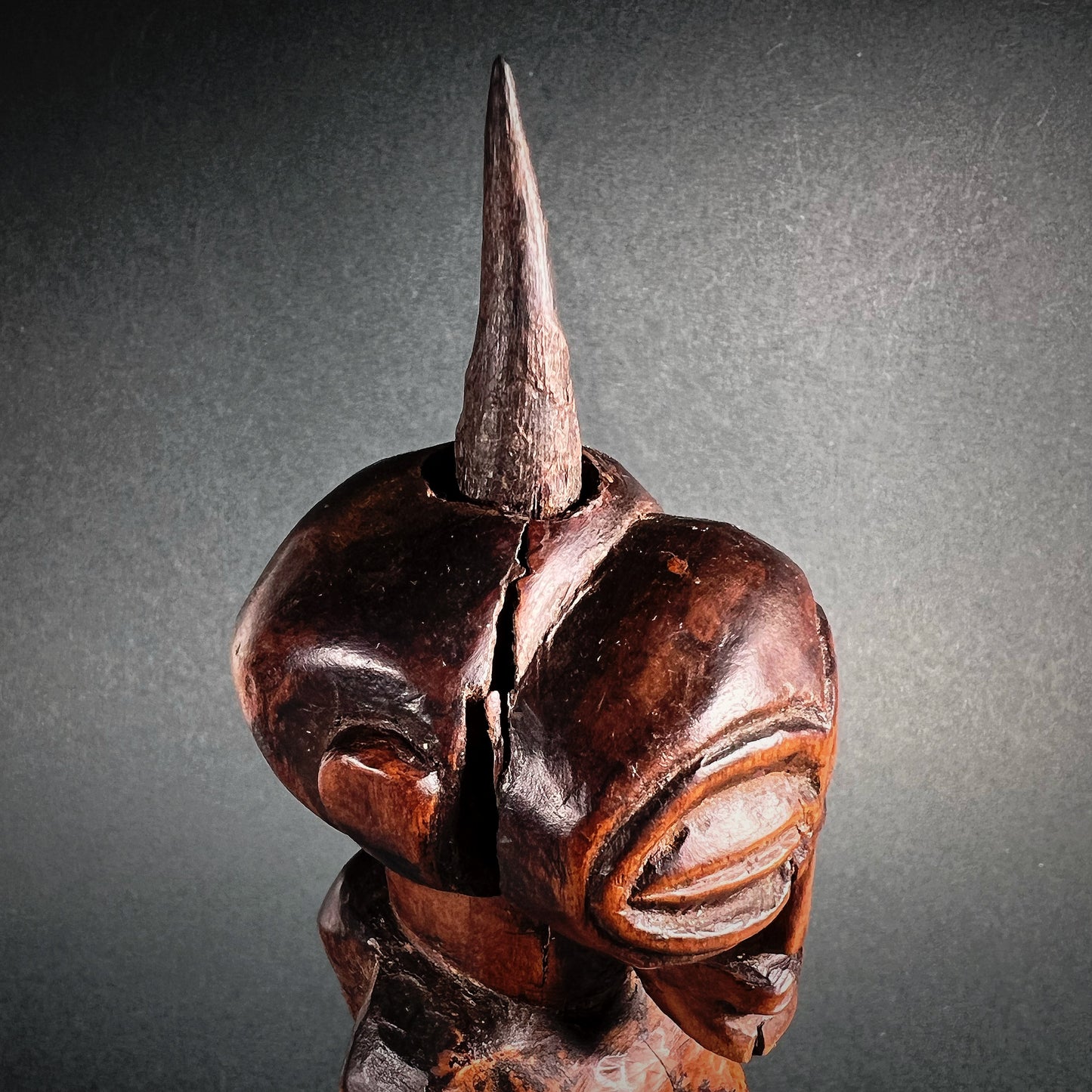Songye Power Figure (Nkisi)
Songye Power Figure (Nkisi)
Couldn't load pickup availability
Songye people, mid-20th century, Democratic Republic of the Congo, Central Africa
A fantastic and mesmerizing small-sized Songye power figure, or nkisi, created through the collaboration of a master sculptor and an initiated ritual practitioner. Carved from a single piece of dense brown wood, the figure has been dyed black and sheathed in sacred materials (bishimba) including horn, fiber, fur, and hide—substances believed to activate and empower the spirit housed within.
The figure’s head exhibits classic Songye aesthetics: large, coffee-bean–shaped eyes closed beneath sharply arched brows; a short, wide, flattened nose; and a small, rectangular, slightly protruding mouth set above an angular jutting chin. The ears are intentionally small and recessed. A short cylindrical neck rises to conical shoulders, giving the figure an almost geometric, architectural elegance. The long tubular arms bend inward, with both hands resting upon the forward-thrusting abdomen and prominent navel—symbols associated with vitality, lineage, and procreation. Bands of animal skin and plant fiber are affixed around the hips and right arm, further energizing the object’s spiritual potency. The short, bent legs stand apart on large, firmly planted feet atop a shallow circular plinth carved in continuity with the figure.
From the crown emerges a small Dik-Dik (Madoqua sp.) horn, an especially potent material referencing the wisdom of elders and serving as a conduit for spiritual force.
The Songye inhabit a broad region between the Sankuru and Lubilash rivers in the west and the Lualaba River in the east, extending across Kasaï-Oriental, Katanga, and the Kivu provinces. Numbering around 150,000 and divided into thirty-five subgroups, the Songye are governed by a paramount chief (Yakitenge) supported by councils of elders (bakulu), noble lineages (bilolo), and numerous secret societies. Their history is deeply intertwined with that of the Luba (Baluba), with whom they share a mythical founding ancestor, Kongolo.
Most traditional Songye sculpture represents nkisi (plural minkisi, also mankishi), spirit-activated figures capable of influencing the realm of the living. Each community maintains a principal nkisi, housed in its own shrine (shibo ya bwanga), used to address collective crises such as crop failure, epidemics, witchcraft, sorcery, or inter-village conflict. Minkisi are entrusted to a designated guardian (nkunja or kunca), often an elder man or woman who dreams for the spirit and interprets signs of possession or spiritual visitation. Individuals also maintain personal minkisi for protection, healing, and communication with ancestors.
The power of any nkisi resides in its bishimba, a complex assemblage of spiritually charged substances prepared by a ritual healer (nganga). These may be inserted into an abdominal cavity, tied around the figure, or—most commonly—embedded within a horn projecting from the head. The figure itself is considered merely a vessel, animated only when the bishimba is added.
Traditional bishimba may include:
• feathers of a hawk (kabemba),
• teeth or claws of a lion (ntembve),
• scales of a dangerous snake (nsanci),
• flesh or bone of a suicide victim,
• hair or nails of an epileptic or albino (nsaka),
• umbilical cords of twins,
as well as symbolically potent materials such as earth from an elephant’s footprint or fragments from a lightning-struck tree (tufi twa mpeshi). Each element carries specific metaphysical properties, forming a complex spiritual chemistry invisible to the uninitiated but essential to Songye cosmology.
A small yet powerful example, this nkisi radiates presence, authority, and ritual depth—a masterful embodiment of Songye sculptural genius and ancestral spiritual technologies.
Good condition. Surface wear and abrasions commensurate with age and use. Parallel split in wood running across the figure. Small chip. Exceptionally fine glossy patina. Traces of encrustation, libations and sacrificial offerings. Size approx. 22,0cm x 5,6cm x 6,0cm (excluding the modern base).
Provenance: From the estate of Jan Ölander, Sweden. From 1984 to 1987, Jan Ölander served as the Swedish ambassador to Zambia and Malawi.
References and further reading:
Reviewing Power, Process, and Statement: The Case of Songye Figures, Dunja Hersak, African Arts, Vol.43, No.2, pp.38-51, Published UCLA, Summer 2010.
On the Consept of Prototype in Songye Masquerades, Dunja Hersak, African Arts, Vol.45, No.2, pp.12-23, Published UCLA, Summer 2012.
Community Poer Figure: Male (Nkisi), Yaëlle Biro, The Metropolitan Museum of Art, 2018.
Songye, Art & Life in Africa, University of Iowa Stanley Museum of Art.






-
Shipping
The shipment will be prepared in the course of 3-5 days and dispatched via Posti Group Oyj or purchased item(s) can be picked up from our shop during the store's opening hours (Tarkk’ampujankatu 4, 00140, Helsinki, Finland). Within the Finland, all items are shipped via Posti Group Oyj unless otherwise requested. We pack the items carefully and mainly in recycled materials because we want to save nature. You will receive the tracking number for your items by e-mail.
-
Returns
Returns and exchange will be accepted within fourteen days (14) of receipt at the purchaser’s cost to include freight and packaging. Items must be returned in the same condition as when they were shipped, and will not be accepted if damaged or altered in any way. Please inform us via email (info@gotanmaailma.fi) or by calling +358408408352 before sending. We do not accept returns more than 14 days after delivery.






